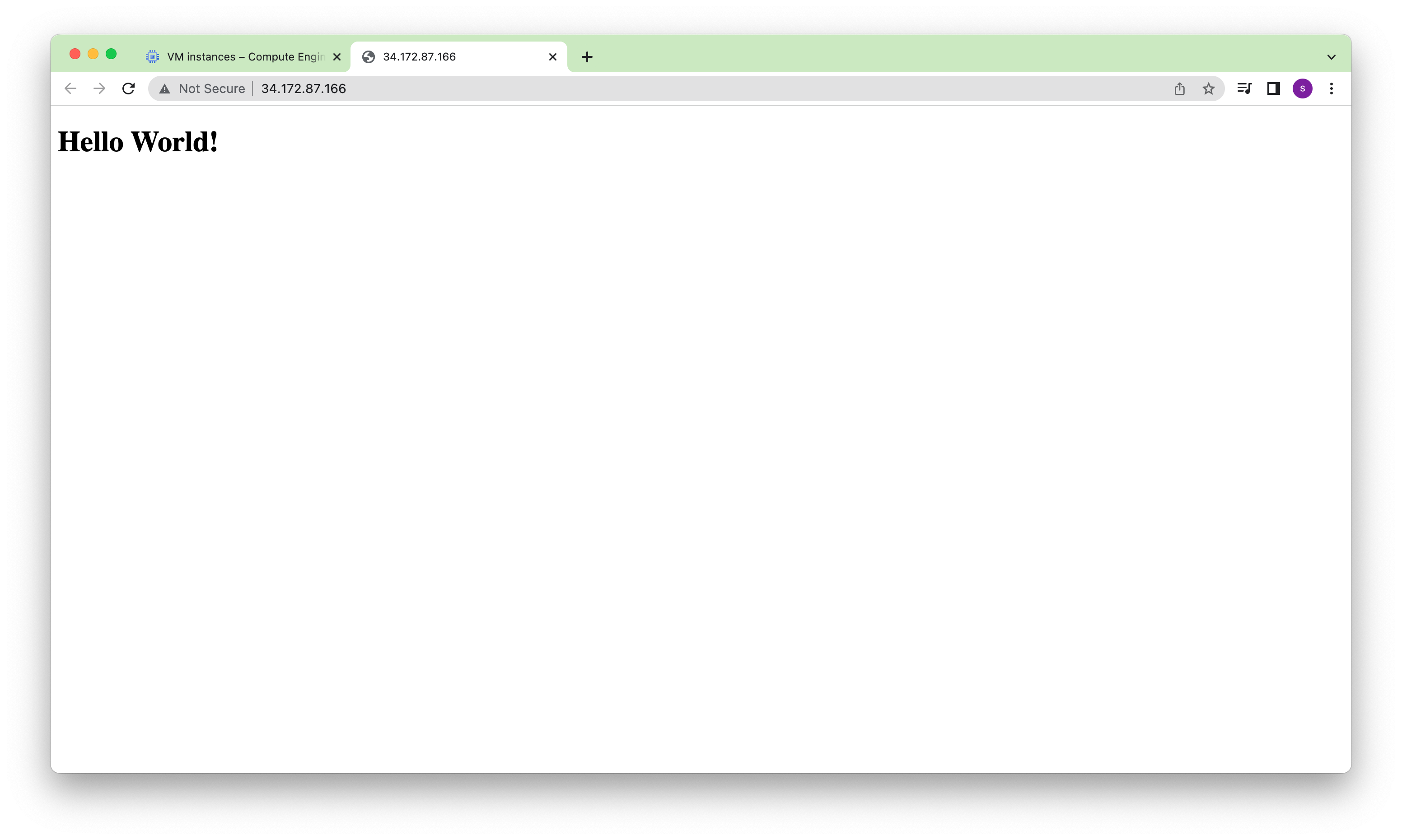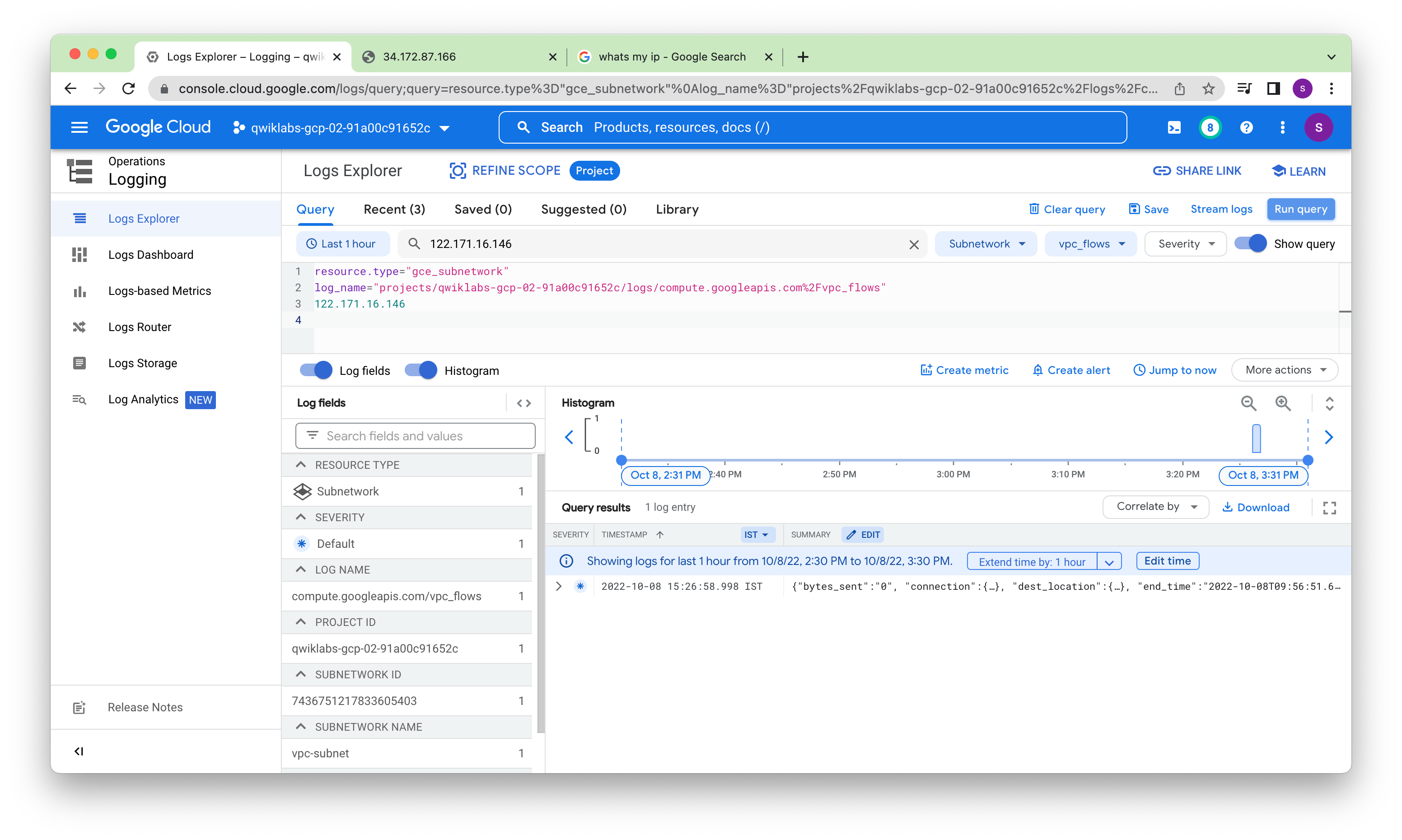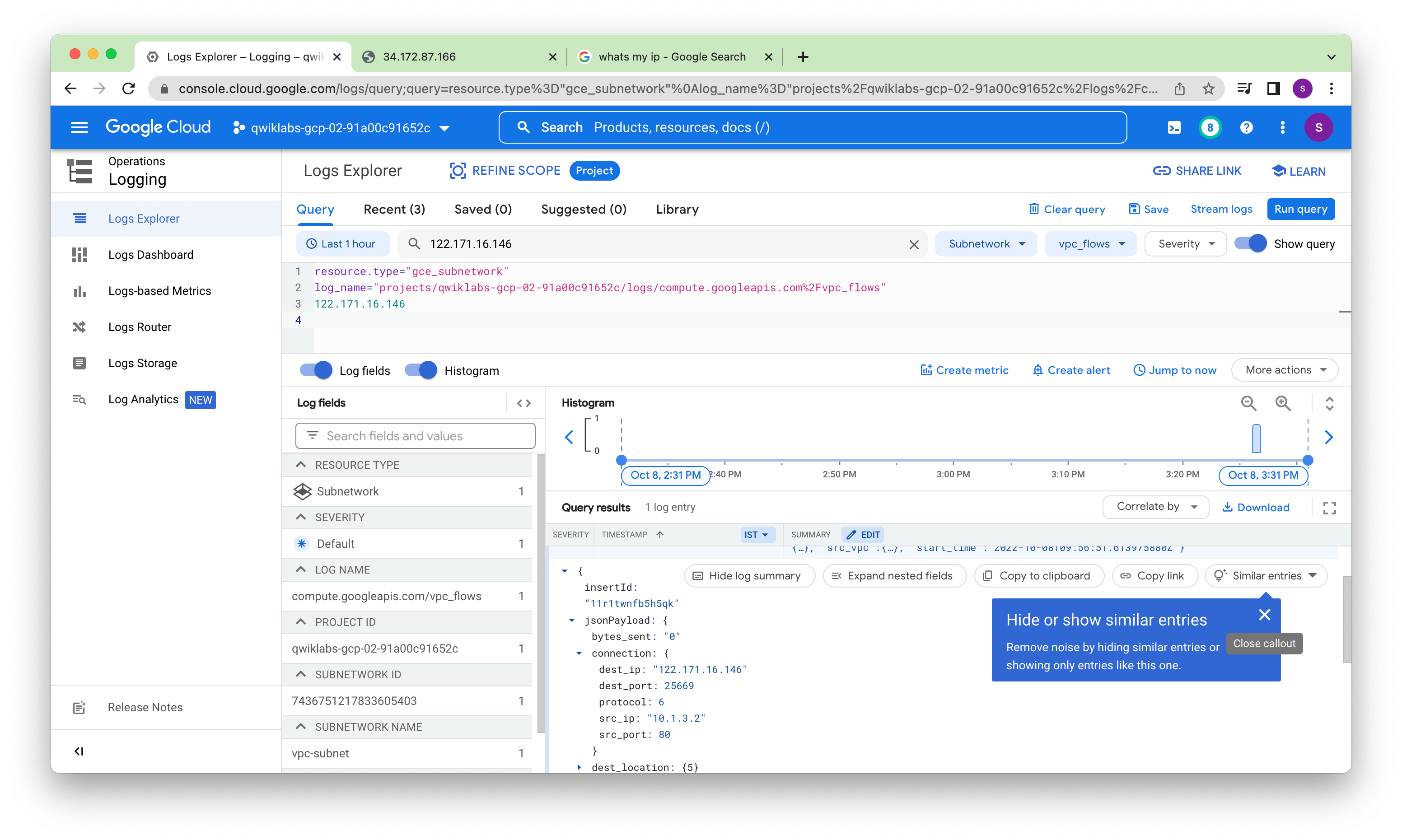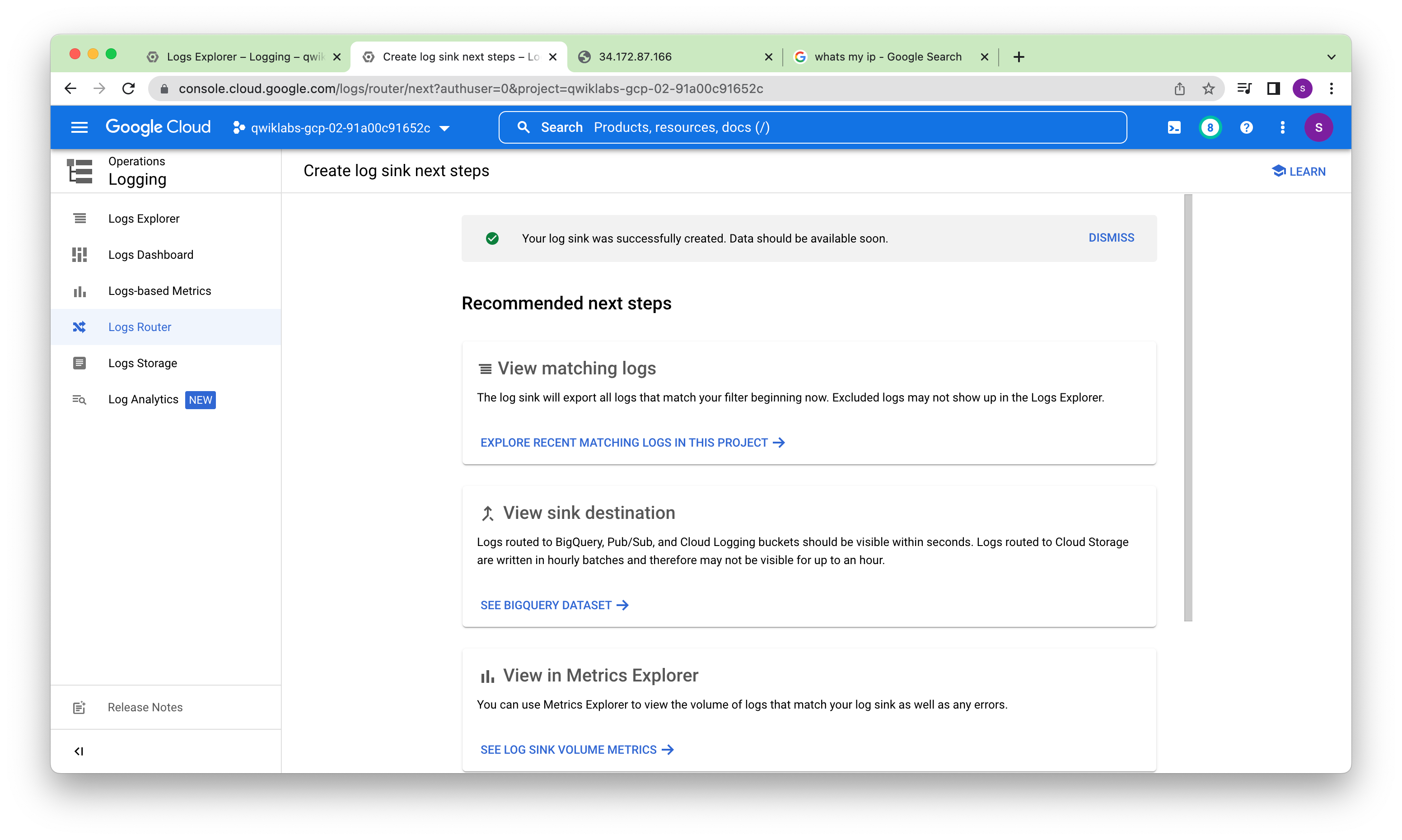Analyzing network traffic with VPC Flow Logs
In this lab, you configure a network to record traffic to and from an Apache web server using VPC Flow Logs. You then export the logs to BigQuery to analyze them.
-
Configure a custom network with VPC Flow Logs
-
Create an Apache web server
-
Verify that network traffic is logged
-
Export the network traffic to BigQuery to further analyze the logs
-
Setup VPC flow log aggregation
Task 1. Configure a custom network with VPC Flow Logs
Create the custom network
gcloud compute networks create vpc-net --project=qwiklabs-gcp-02-91a00c91652c --subnet-mode=custom --mtu=1460 --bgp-routing-mode=regional
gcloud compute networks subnets create vpc-subnet --project=qwiklabs-gcp-02-91a00c91652c --range=10.1.3.0/24 --stack-type=IPV4_ONLY --network=vpc-net --region=us-central1 --enable-flow-logs --logging-aggregation-interval=interval-5-sec --logging-flow-sampling=0.5 --logging-metadata=include-all
Turning on VPC flow logs doesn’t affect performance, but some systems generate a large number of logs, which can increase costs. If you click on Configure logs you’ll notice that you can modify the aggregation interval and sample rate. This allows you to trade off longer interval updates for lower data volume generation which lowers logging costs.
Create the firewall rule In order to serve HTTP and SSH traffic on the network, you need to create a firewall rule.
gcloud compute --project=qwiklabs-gcp-02-91a00c91652c firewall-rules create allow-http-ssh --direction=INGRESS --priority=1000 --network=vpc-net --action=ALLOW --rules=tcp:22,tcp:80 --source-ranges=0.0.0.0/0 --target-tags=http-server
Task 2. Create an Apache web server
Create the web server
gcloud compute instances create web-server --project=qwiklabs-gcp-02-91a00c91652c --zone=us-central1-c --machine-type=f1-micro --network-interface=network-tier=PREMIUM,subnet=vpc-subnet --metadata=enable-oslogin=true --maintenance-policy=MIGRATE --provisioning-model=STANDARD --service-account=361062432930-compute@developer.gserviceaccount.com --scopes=https://www.googleapis.com/auth/devstorage.read_only,https://www.googleapis.com/auth/logging.write,https://www.googleapis.com/auth/monitoring.write,https://www.googleapis.com/auth/servicecontrol,https://www.googleapis.com/auth/service.management.readonly,https://www.googleapis.com/auth/trace.append --tags=http-server --create-disk=auto-delete=yes,boot=yes,device-name=web-server,image=projects/debian-cloud/global/images/debian-11-bullseye-v20220920,mode=rw,size=10,type=projects/qwiklabs-gcp-02-91a00c91652c/zones/us-central1-c/diskTypes/pd-balanced --no-shielded-secure-boot --shielded-vtpm --shielded-integrity-monitoring --reservation-affinity=any
Install Apache Configure the VM instance that you created as an Apache web server, and overwrite the default web page
Linux web-server 5.10.0-18-cloud-amd64 #1 SMP Debian 5.10.140-1 (2022-09-02) x86_64
The programs included with the Debian GNU/Linux system are free software;
the exact distribution terms for each program are described in the
individual files in /usr/share/doc/*/copyright.
Debian GNU/Linux comes with ABSOLUTELY NO WARRANTY, to the extent
permitted by applicable law.
student-01-e3c2b9ab4419@web-server:~$ sudo apt-get update
Get:1 http://security.debian.org/debian-security bullseye-security InRelease [48.4 kB]
Hit:2 http://deb.debian.org/debian bullseye InRelease
Get:3 http://deb.debian.org/debian bullseye-updates InRelease [44.1 kB]
Get:4 http://deb.debian.org/debian bullseye-backports InRelease [49.0 kB]
Get:5 http://security.debian.org/debian-security bullseye-security/main Sources [160 kB]
Get:6 http://security.debian.org/debian-security bullseye-security/main amd64 Packages [189 kB]
Get:7 http://security.debian.org/debian-security bullseye-security/main Translation-en [119 kB]
Get:8 http://packages.cloud.google.com/apt cloud-sdk-bullseye InRelease [6781 B]
Get:9 http://deb.debian.org/debian bullseye-updates/main Sources.diff/Index [11.7 kB]
Get:10 http://deb.debian.org/debian bullseye-updates/main amd64 Packages.diff/Index [11.7 kB]
Get:11 http://deb.debian.org/debian bullseye-updates/main Translation-en.diff/Index [4995 B]
Get:12 http://deb.debian.org/debian bullseye-updates/main Sources T-2022-10-02-2032.44-F-2022-09-22-1635.40.pdiff [2486 B]
Get:13 http://deb.debian.org/debian bullseye-updates/main amd64 Packages T-2022-10-02-2032.44-F-2022-09-22-1635.40.pdiff [4713 B]
Get:12 http://deb.debian.org/debian bullseye-updates/main Sources T-2022-10-02-2032.44-F-2022-09-22-1635.40.pdiff [2486 B]
Get:13 http://deb.debian.org/debian bullseye-updates/main amd64 Packages T-2022-10-02-2032.44-F-2022-09-22-1635.40.pdiff [4713 B]
Get:14 http://deb.debian.org/debian bullseye-backports/main Sources.diff/Index [63.3 kB]
Get:15 http://deb.debian.org/debian bullseye-backports/main amd64 Packages.diff/Index [63.3 kB]
Get:16 http://deb.debian.org/debian bullseye-backports/main Translation-en.diff/Index [63.3 kB]
Get:17 http://deb.debian.org/debian bullseye-updates/main Translation-en T-2022-09-22-1635.40-F-2022-09-22-1635.40.pdiff [3855 B]
Get:17 http://deb.debian.org/debian bullseye-updates/main Translation-en T-2022-09-22-1635.40-F-2022-09-22-1635.40.pdiff [3855 B]
Get:18 http://deb.debian.org/debian bullseye-backports/main Sources T-2022-10-08-0805.07-F-2022-09-22-0435.24.pdiff [61.0 kB]
Get:19 http://deb.debian.org/debian bullseye-backports/main amd64 Packages T-2022-10-08-0805.07-F-2022-09-22-1115.32.pdiff [67.6 kB]
Get:18 http://deb.debian.org/debian bullseye-backports/main Sources T-2022-10-08-0805.07-F-2022-09-22-0435.24.pdiff [61.0 kB]
Get:19 http://deb.debian.org/debian bullseye-backports/main amd64 Packages T-2022-10-08-0805.07-F-2022-09-22-1115.32.pdiff [67.6 kB]
Get:20 http://deb.debian.org/debian bullseye-backports/main Translation-en T-2022-10-07-1403.51-F-2022-09-22-1115.32.pdiff [28.2 kB]
Get:20 http://deb.debian.org/debian bullseye-backports/main Translation-en T-2022-10-07-1403.51-F-2022-09-22-1115.32.pdiff [28.2 kB]
Get:21 http://packages.cloud.google.com/apt google-cloud-packages-archive-keyring-bullseye InRelease [5557 B]
Get:22 http://packages.cloud.google.com/apt google-compute-engine-bullseye-stable InRelease [5533 B]
Get:23 http://packages.cloud.google.com/apt cloud-sdk-bullseye/main amd64 Packages [185 kB]
Get:24 http://packages.cloud.google.com/apt google-cloud-packages-archive-keyring-bullseye/main amd64 Packages [387 B]
Fetched 1198 kB in 1s (843 kB/s)
Reading package lists... Done
student-01-e3c2b9ab4419@web-server:~$ sudo apt-get install apache2 -y
Reading package lists... Done
Building dependency tree... Done
Reading state information... Done
The following additional packages will be installed:
apache2-bin apache2-data apache2-utils bzip2 file libapr1 libaprutil1 libaprutil1-dbd-sqlite3
libaprutil1-ldap libgdbm-compat4 libicu67 libjansson4 liblua5.3-0 libmagic-mgc libmagic1 libperl5.32
libxml2 mailcap mime-support perl perl-modules-5.32 ssl-cert
Suggested packages:
apache2-doc apache2-suexec-pristine | apache2-suexec-custom www-browser bzip2-doc perl-doc
libterm-readline-gnu-perl | libterm-readline-perl-perl make libtap-harness-archive-perl
The following NEW packages will be installed:
apache2 apache2-bin apache2-data apache2-utils bzip2 file libapr1 libaprutil1 libaprutil1-dbd-sqlite3
libaprutil1-ldap libgdbm-compat4 libicu67 libjansson4 liblua5.3-0 libmagic-mgc libmagic1 libperl5.32
libxml2 mailcap mime-support perl perl-modules-5.32 ssl-cert
0 upgraded, 23 newly installed, 0 to remove and 12 not upgraded.
Need to get 19.7 MB of archives.
After this operation, 98.9 MB of additional disk space will be used.
Get:1 http://deb.debian.org/debian bullseye/main amd64 perl-modules-5.32 all 5.32.1-4+deb11u2 [2823 kB]
Get:2 http://deb.debian.org/debian bullseye/main amd64 libgdbm-compat4 amd64 1.19-2 [44.7 kB]
Get:3 http://deb.debian.org/debian bullseye/main amd64 libperl5.32 amd64 5.32.1-4+deb11u2 [4106 kB]
Get:4 http://deb.debian.org/debian bullseye/main amd64 perl amd64 5.32.1-4+deb11u2 [293 kB]
Get:5 http://deb.debian.org/debian bullseye/main amd64 libapr1 amd64 1.7.0-6+deb11u1 [106 kB]
Get:6 http://deb.debian.org/debian bullseye/main amd64 libaprutil1 amd64 1.6.1-5 [92.1 kB]
Get:7 http://deb.debian.org/debian bullseye/main amd64 libaprutil1-dbd-sqlite3 amd64 1.6.1-5 [18.8 kB]
Get:8 http://deb.debian.org/debian bullseye/main amd64 libaprutil1-ldap amd64 1.6.1-5 [17.0 kB]
Get:9 http://deb.debian.org/debian bullseye/main amd64 libjansson4 amd64 2.13.1-1.1 [39.7 kB]
Get:10 http://deb.debian.org/debian bullseye/main amd64 liblua5.3-0 amd64 5.3.3-1.1+b1 [120 kB]
Get:11 http://deb.debian.org/debian bullseye/main amd64 libicu67 amd64 67.1-7 [8622 kB]
Get:12 http://deb.debian.org/debian bullseye/main amd64 libxml2 amd64 2.9.10+dfsg-6.7+deb11u2 [692 kB]
Get:13 http://deb.debian.org/debian bullseye/main amd64 apache2-bin amd64 2.4.54-1~deb11u1 [1425 kB]
Get:14 http://deb.debian.org/debian bullseye/main amd64 apache2-data all 2.4.54-1~deb11u1 [160 kB]
Get:15 http://deb.debian.org/debian bullseye/main amd64 apache2-utils amd64 2.4.54-1~deb11u1 [260 kB]
Get:16 http://deb.debian.org/debian bullseye/main amd64 mailcap all 3.69 [31.7 kB]
Get:17 http://deb.debian.org/debian bullseye/main amd64 mime-support all 3.66 [10.9 kB]
Get:18 http://deb.debian.org/debian bullseye/main amd64 apache2 amd64 2.4.54-1~deb11u1 [275 kB]
Get:19 http://deb.debian.org/debian bullseye/main amd64 bzip2 amd64 1.0.8-4 [49.3 kB]
Get:20 http://deb.debian.org/debian bullseye/main amd64 libmagic-mgc amd64 1:5.39-3 [273 kB]
Get:21 http://deb.debian.org/debian bullseye/main amd64 libmagic1 amd64 1:5.39-3 [126 kB]
Get:22 http://deb.debian.org/debian bullseye/main amd64 file amd64 1:5.39-3 [69.1 kB]
Get:23 http://deb.debian.org/debian bullseye/main amd64 ssl-cert all 1.1.0+nmu1 [21.0 kB]
Fetched 19.7 MB in 1s (26.2 MB/s)
Preconfiguring packages ...
Selecting previously unselected package perl-modules-5.32.
(Reading database ... 53755 files and directories currently installed.)
Preparing to unpack .../00-perl-modules-5.32_5.32.1-4+deb11u2_all.deb ...
Unpacking perl-modules-5.32 (5.32.1-4+deb11u2) ...
Selecting previously unselected package libgdbm-compat4:amd64.
Preparing to unpack .../01-libgdbm-compat4_1.19-2_amd64.deb ...
Unpacking libgdbm-compat4:amd64 (1.19-2) ...
Selecting previously unselected package libperl5.32:amd64.
Preparing to unpack .../02-libperl5.32_5.32.1-4+deb11u2_amd64.deb ...
Unpacking libperl5.32:amd64 (5.32.1-4+deb11u2) ...
Selecting previously unselected package perl.
Preparing to unpack .../03-perl_5.32.1-4+deb11u2_amd64.deb ...
Unpacking perl (5.32.1-4+deb11u2) ...
Selecting previously unselected package libapr1:amd64.
Preparing to unpack .../04-libapr1_1.7.0-6+deb11u1_amd64.deb ...
Unpacking libapr1:amd64 (1.7.0-6+deb11u1) ...
Selecting previously unselected package libaprutil1:amd64.
Preparing to unpack .../05-libaprutil1_1.6.1-5_amd64.deb ...
Unpacking libaprutil1:amd64 (1.6.1-5) ...
Selecting previously unselected package libaprutil1-dbd-sqlite3:amd64.
Preparing to unpack .../06-libaprutil1-dbd-sqlite3_1.6.1-5_amd64.deb ...
Unpacking libaprutil1-dbd-sqlite3:amd64 (1.6.1-5) ...
Selecting previously unselected package libaprutil1-ldap:amd64.
Preparing to unpack .../07-libaprutil1-ldap_1.6.1-5_amd64.deb ...
Unpacking libaprutil1-ldap:amd64 (1.6.1-5) ...
Selecting previously unselected package libjansson4:amd64.
Preparing to unpack .../08-libjansson4_2.13.1-1.1_amd64.deb ...
Unpacking libjansson4:amd64 (2.13.1-1.1) ...
Selecting previously unselected package liblua5.3-0:amd64.
Preparing to unpack .../09-liblua5.3-0_5.3.3-1.1+b1_amd64.deb ...
Unpacking liblua5.3-0:amd64 (5.3.3-1.1+b1) ...
Selecting previously unselected package libicu67:amd64.
Preparing to unpack .../10-libicu67_67.1-7_amd64.deb ...
Unpacking libicu67:amd64 (67.1-7) ...
Selecting previously unselected package libxml2:amd64.
Preparing to unpack .../11-libxml2_2.9.10+dfsg-6.7+deb11u2_amd64.deb ...
Unpacking libxml2:amd64 (2.9.10+dfsg-6.7+deb11u2) ...
Selecting previously unselected package apache2-bin.
Preparing to unpack .../12-apache2-bin_2.4.54-1~deb11u1_amd64.deb ...
Unpacking apache2-bin (2.4.54-1~deb11u1) ...
Selecting previously unselected package apache2-data.
Preparing to unpack .../13-apache2-data_2.4.54-1~deb11u1_all.deb ...
Unpacking apache2-data (2.4.54-1~deb11u1) ...
Selecting previously unselected package apache2-utils.
Preparing to unpack .../14-apache2-utils_2.4.54-1~deb11u1_amd64.deb ...
Unpacking apache2-utils (2.4.54-1~deb11u1) ...
Selecting previously unselected package mailcap.
Preparing to unpack .../15-mailcap_3.69_all.deb ...
Unpacking mailcap (3.69) ...
Selecting previously unselected package mime-support.
Preparing to unpack .../16-mime-support_3.66_all.deb ...
Unpacking mime-support (3.66) ...
Selecting previously unselected package apache2.
Preparing to unpack .../17-apache2_2.4.54-1~deb11u1_amd64.deb ...
Unpacking apache2 (2.4.54-1~deb11u1) ...
Selecting previously unselected package bzip2.
Preparing to unpack .../18-bzip2_1.0.8-4_amd64.deb ...
Unpacking bzip2 (1.0.8-4) ...
Selecting previously unselected package libmagic-mgc.
Preparing to unpack .../19-libmagic-mgc_1%3a5.39-3_amd64.deb ...
Unpacking libmagic-mgc (1:5.39-3) ...
Selecting previously unselected package libmagic1:amd64.
Preparing to unpack .../20-libmagic1_1%3a5.39-3_amd64.deb ...
Unpacking libmagic1:amd64 (1:5.39-3) ...
Selecting previously unselected package file.
Preparing to unpack .../21-file_1%3a5.39-3_amd64.deb ...
Unpacking file (1:5.39-3) ...
Selecting previously unselected package ssl-cert.
Preparing to unpack .../22-ssl-cert_1.1.0+nmu1_all.deb ...
Unpacking ssl-cert (1.1.0+nmu1) ...
Setting up libicu67:amd64 (67.1-7) ...
Setting up libmagic-mgc (1:5.39-3) ...
Setting up perl-modules-5.32 (5.32.1-4+deb11u2) ...
Setting up libmagic1:amd64 (1:5.39-3) ...
Setting up libapr1:amd64 (1.7.0-6+deb11u1) ...
Setting up file (1:5.39-3) ...
Setting up bzip2 (1.0.8-4) ...
Setting up libjansson4:amd64 (2.13.1-1.1) ...
Setting up ssl-cert (1.1.0+nmu1) ...
Setting up libgdbm-compat4:amd64 (1.19-2) ...
Setting up libperl5.32:amd64 (5.32.1-4+deb11u2) ...
Setting up liblua5.3-0:amd64 (5.3.3-1.1+b1) ...
Setting up apache2-data (2.4.54-1~deb11u1) ...
Setting up libxml2:amd64 (2.9.10+dfsg-6.7+deb11u2) ...
Setting up libaprutil1:amd64 (1.6.1-5) ...
Setting up libaprutil1-ldap:amd64 (1.6.1-5) ...
Setting up libaprutil1-dbd-sqlite3:amd64 (1.6.1-5) ...
Setting up perl (5.32.1-4+deb11u2) ...
Setting up mailcap (3.69) ...
Setting up apache2-utils (2.4.54-1~deb11u1) ...
Setting up mime-support (3.66) ...
Setting up apache2-bin (2.4.54-1~deb11u1) ...
Setting up apache2 (2.4.54-1~deb11u1) ...
Enabling module mpm_event.
Enabling module authz_core.
Enabling module authz_host.
Enabling module authn_core.
Enabling module auth_basic.
Enabling module access_compat.
Enabling module authn_file.
Enabling module authz_user.
Enabling module alias.
Enabling module dir.
Enabling module autoindex.
Enabling module env.
Enabling module mime.
Enabling module negotiation.
Enabling module setenvif.
Enabling module filter.
Enabling module deflate.
Enabling module status.
Enabling module reqtimeout.
Enabling conf charset.
Enabling conf localized-error-pages.
Enabling conf other-vhosts-access-log.
Enabling conf security.
Enabling conf serve-cgi-bin.
Enabling site 000-default.
Created symlink /etc/systemd/system/multi-user.target.wants/apache2.service → /lib/systemd/system/apache2.service.
Created symlink /etc/systemd/system/multi-user.target.wants/apache-htcacheclean.service → /lib/systemd/system/apache-htcacheclean.service.
Processing triggers for man-db (2.9.4-2) ...
Processing triggers for libc-bin (2.31-13+deb11u4) ...
student-01-e3c2b9ab4419@web-server:~$ echo '<!doctype html><html><body><h1>Hello World!</h1></body></html>' | sudo tee /var/www/html/index.html
<!doctype html><html><body><h1>Hello World!</h1></body></html>
student-01-e3c2b9ab4419@web-server:~$
Task 3. Verify that network traffic is logged

Access the VPC Flow Logs In the Cloud Console, go to Navigation menu > Logging > Logs Explorer.
In the Log fields panel, under Resource type, click Subnetwork. In the Query results pane, entries from the subnetwork logs appear.
In the Log fields panel, under Log name, click compute.googleapis.com/vpc_flows.
Enter "YOUR_IP_ADDRESS" in the Query search box at the top. Then Click Run Query.


resource.type="gce_subnetwork"
log_name="projects/qwiklabs-gcp-03-9a1e7be07c45/logs/compute.googleapis.com%2Fvpc_flows"
"122.171.20.79"
{
"insertId": "1ac59m6fh4mq35",
"jsonPayload": {
"connection": {
"src_port": 4566,
"dest_ip": "10.1.3.2",
"dest_port": 80,
"protocol": 6,
"src_ip": "122.171.20.79"
},
"dest_instance": {
"project_id": "qwiklabs-gcp-03-9a1e7be07c45",
"region": "us-east1",
"zone": "us-east1-c",
"vm_name": "web-server"
},
"end_time": "2024-07-07T06:47:28.252975448Z",
"reporter": "DEST",
"src_location": {
"asn": 24560,
"continent": "Asia",
"country": "ind",
"region": "Karnataka",
"city": "Bengaluru"
},
"bytes_sent": "0",
"packets_sent": "8",
"dest_vpc": {
"vpc_name": "vpc-net",
"subnetwork_name": "vpc-subnet",
"project_id": "qwiklabs-gcp-03-9a1e7be07c45"
},
"start_time": "2024-07-07T06:47:27.992698117Z"
},
"resource": {
"type": "gce_subnetwork",
"labels": {
"location": "us-east1",
"subnetwork_name": "vpc-subnet",
"project_id": "qwiklabs-gcp-03-9a1e7be07c45",
"subnetwork_id": "4356594977366050425"
}
},
"timestamp": "2024-07-07T06:47:37.036054126Z",
"logName": "projects/qwiklabs-gcp-03-9a1e7be07c45/logs/compute.googleapis.com%2Fvpc_flows",
"receiveTimestamp": "2024-07-07T06:47:37.036054126Z"
}
Task 4. Export the network traffic to BigQuery to further analyze the logs
In the Console, in the left pane, click Logs Explorer.
From Resources dropdown, select Subnetwork. Then click Apply.
From Log name dropdown, check vpc_flows and click Apply. Then, click Run query.
Click More Actions > Create Sink.
For “Sink Name”, type vpc-flows and click NEXT.
For “Select sink service”, select the BigQuery dataset.
For “Sink Destination”, select Create new BigQuery dataset.
For “Dataset ID”, type bq_vpcflows, and then click CREATE DATASET.
Click CREATE SINK. The Logs Router Sinks page appears. You should be able to see the sink you created (vpc-flows). If you are unable to see the sink click on Logs Router.
Create an export sink

Generate log traffic for BigQuery Now that the network traffic logs are being exported to BigQuery, generate more traffic by accessing the web-server several times. Using Cloud Shell, you can curl the IP address of the web-server several times.
Welcome to Cloud Shell! Type "help" to get started.
Your Cloud Platform project in this session is set to qwiklabs-gcp-02-91a00c91652c.
Use “gcloud config set project [PROJECT_ID]” to change to a different project.
student_01_e3c2b9ab4419@cloudshell:~ (qwiklabs-gcp-02-91a00c91652c)$ export MY_SERVER=34.172.87.166
student_01_e3c2b9ab4419@cloudshell:~ (qwiklabs-gcp-02-91a00c91652c)$ for ((i=1;i<=50;i++)); do curl $MY_SERVER; done
<!doctype html><html><body><h1>Hello World!</h1></body></html>
<!doctype html><html><body><h1>Hello World!</h1></body></html>
<!doctype html><html><body><h1>Hello World!</h1></body></html>
<!doctype html><html><body><h1>Hello World!</h1></body></html>
<!doctype html><html><body><h1>Hello World!</h1></body></html>
<!doctype html><html><body><h1>Hello World!</h1></body></html>
<!doctype html><html><body><h1>Hello World!</h1></body></html>
<!doctype html><html><body><h1>Hello World!</h1></body></html>
<!doctype html><html><body><h1>Hello World!</h1></body></html>
<!doctype html><html><body><h1>Hello World!</h1></body></html>
<!doctype html><html><body><h1>Hello World!</h1></body></html>
<!doctype html><html><body><h1>Hello World!</h1></body></html>
<!doctype html><html><body><h1>Hello World!</h1></body></html>
<!doctype html><html><body><h1>Hello World!</h1></body></html>
<!doctype html><html><body><h1>Hello World!</h1></body></html>
<!doctype html><html><body><h1>Hello World!</h1></body></html>
<!doctype html><html><body><h1>Hello World!</h1></body></html>
<!doctype html><html><body><h1>Hello World!</h1></body></html>
<!doctype html><html><body><h1>Hello World!</h1></body></html>
<!doctype html><html><body><h1>Hello World!</h1></body></html>
<!doctype html><html><body><h1>Hello World!</h1></body></html>
<!doctype html><html><body><h1>Hello World!</h1></body></html>
<!doctype html><html><body><h1>Hello World!</h1></body></html>
<!doctype html><html><body><h1>Hello World!</h1></body></html>
<!doctype html><html><body><h1>Hello World!</h1></body></html>
<!doctype html><html><body><h1>Hello World!</h1></body></html>
<!doctype html><html><body><h1>Hello World!</h1></body></html>
<!doctype html><html><body><h1>Hello World!</h1></body></html>
<!doctype html><html><body><h1>Hello World!</h1></body></html>
<!doctype html><html><body><h1>Hello World!</h1></body></html>
<!doctype html><html><body><h1>Hello World!</h1></body></html>
<!doctype html><html><body><h1>Hello World!</h1></body></html>
<!doctype html><html><body><h1>Hello World!</h1></body></html>
<!doctype html><html><body><h1>Hello World!</h1></body></html>
<!doctype html><html><body><h1>Hello World!</h1></body></html>
<!doctype html><html><body><h1>Hello World!</h1></body></html>
<!doctype html><html><body><h1>Hello World!</h1></body></html>
<!doctype html><html><body><h1>Hello World!</h1></body></html>
<!doctype html><html><body><h1>Hello World!</h1></body></html>
<!doctype html><html><body><h1>Hello World!</h1></body></html>
<!doctype html><html><body><h1>Hello World!</h1></body></html>
<!doctype html><html><body><h1>Hello World!</h1></body></html>
<!doctype html><html><body><h1>Hello World!</h1></body></html>
<!doctype html><html><body><h1>Hello World!</h1></body></html>
<!doctype html><html><body><h1>Hello World!</h1></body></html>
<!doctype html><html><body><h1>Hello World!</h1></body></html>
<!doctype html><html><body><h1>Hello World!</h1></body></html>
<!doctype html><html><body><h1>Hello World!</h1></body></html>
<!doctype html><html><body><h1>Hello World!</h1></body></html>
<!doctype html><html><body><h1>Hello World!</h1></body></html>
student_01_e3c2b9ab4419@cloudshell:~ (qwiklabs-gcp-02-91a00c91652c)$
Visualize the VPC Flow Logs in BigQuery In the Cloud Console, on the Navigation menu, click BigQuery.
- In the Console, navigate to Navigation menu (
) > BigQuery.
- Click Done.
- On the left-hand side, expand the bq_vpcflows dataset to reveal the table. You might have to first expand the Project ID to reveal the dataset.
- Click on the name of the table. It should start with compute_googleapis.
- Click on Details tab.
- Copy the Table ID provided in the
Detailstab. - Add the following to the Query Editor and replace your_table_id with
TABLE_IDwhile leaving the accents (`) on both sides:
#standardSQL
SELECT
jsonPayload.src_vpc.vpc_name,
SUM(CAST(jsonPayload.bytes_sent AS INT64)) AS bytes,
jsonPayload.src_vpc.subnetwork_name,
jsonPayload.connection.src_ip,
jsonPayload.connection.src_port,
jsonPayload.connection.dest_ip,
jsonPayload.connection.dest_port,
jsonPayload.connection.protocol
FROM
`qwiklabs-gcp-03-9a1e7be07c45.bq_vpcflows.compute_googleapis_com_vpc_flows_20240707`
GROUP BY
jsonPayload.src_vpc.vpc_name,
jsonPayload.src_vpc.subnetwork_name,
jsonPayload.connection.src_ip,
jsonPayload.connection.src_port,
jsonPayload.connection.dest_ip,
jsonPayload.connection.dest_port,
jsonPayload.connection.protocol
ORDER BY
bytes DESC
LIMIT
15
The results table shows the total bytes sent, source IP address, destination IP address, destination port, protocol, and the respective vpc name and subnet name.
Analyze the VPC Flow Logs in BigQuery
The previous query gave you the same information that you saw in the Cloud Console. Now change the query to identify the top IP addresses that have exchanged traffic with your web-server.
- Create a new query in the Query Editor with the following and replace your_table_id with
TABLE_IDwhile leaving the accents (`) on both sides - The results table now has a row for each source IP and is sorted by the highest amount of bytes sent to the web-server. The top result should reflect your Cloud Shell IP address.
[{
"src_ip": "34.143.173.99",
"dest_ip": "10.1.3.2",
"bytes": "3120",
"dest_port": "80.0",
"protocol": "6.0"
}]
Task 5. Add VPC Flow Log aggregation
In this task, you will now explore a new release of VPC flow log volume reduction. Not every packet is captured into its own log record. However, even with sampling, log record captures can be quite large.
You can balance your traffic visibility and storage cost needs by adjusting specific aspects of logs collection, which you will explore in this section.
-
In the Console, navigate to Navigation menu (
) > VPC network > VPC networks.
-
Click vpc-net, and then click Edit.
-
In the Subnets tab, click vpc-subnet:
-
Click Edit > Configure logs to expose the following fields:
-
The purpose of each field is explained below:
- Aggregation time interval: Sampled packets for a time interval are aggregated into a single log entry. This time interval can be 5 sec (default), 30 sec, 1 min, 5 min, 10 min, or 15 min.
- Metadata annotations: By default, flow log entries are annotated with metadata information, such as the names of the source and destination VMs or the geographic region of external sources and destinations. This metadata annotation can be turned off to save storage space.
- Log entry sampling: Before being written to the database, the number of logs can be sampled to reduce their number. By default, the log entry volume is scaled by 0.50 (50%), which means that half of entries are kept. You can set this from 1.0 (100%, all log entries are kept) to 0.0 (0%, no logs are kept).
- Set the Aggregation Interval to 30 seconds.
- Set the Sample rate to 25%.
- Click Save.
Setting the aggregation level to 30 seconds can reduce your flow logs size by up to 83% compared to the default aggregation interval of 5 seconds. Configuring your flow log aggregation can seriously affect your traffic visibility and storage costs.
Review You configured a VPC network, enabled VPC Flow Logs, and created a web server in that network. Then, you generated HTTP traffic to the web server, viewed the traffic logs in the Cloud Console, and analyzed the traffic logs in BigQuery. Finally, you used VPC Flow Log aggregation for balancing your traffic visibility and storage cost.
There are multiple use cases for VPC Flow Logs. For example, you might use VPC Flow Logs to determine where your applications are being accessed from in order to optimize network traffic expense, to create HTTP load balancers to balance traffic globally, or to deny unwanted IP addresses with Cloud Armor.



